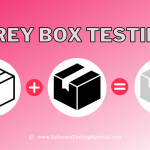
Grey Box Testing
Content
What is Grey Box Testing?
Grey box or Gray box testing is a type of testing in which testing is carried out based on the partial knowledge of the underlying design and implementation of the system.
It is a combination of black box and white box testing techniques. In a black-box testing technique, testers test the functionalities of the system and are unaware of the internal structure of the system. While in white box testing, testers test the internal code structure of the system.
Grey box testing is mainly used in integration testing and penetration testing. Integration testing is the testing of individual modules of the system as a group. While penetration testing is done by reproducing various scenarios that can cause malicious hacking attempts and finding system vulnerabilities against such attacks.
Example
Let’s take an example of a software application on which the tester has access to the database. The tester can check all the data inserted in the database along with the data type of each field of different tables.
Now based on the understanding of the database fields – the type of data they can hold and the range of values they can contain, the tester can design the positive and negative test cases keeping these things in mind. In this way, with access to the database, the tester can create better test cases and hence, perform better testing.
Strategy for Grey Box Testing
First, based on the white box testing method, testers study various design documents and understand the basic internal mechanism of the application. In grey box testing, as stated earlier, complete access to source code is not required by the tester but limited knowledge of internal working is enough.
Testers design test cases based on his/her knowledge of internal data structures, algorithms, UML diagrams, system architecture, etc.
Once test cases have been designed, testers execute them using the black-box testing method.
Techniques used for Grey Box Testing
- Matrix Testing – In matrix testing, all the variables of the application are defined by the developers. Each of these variables has business and technical risks associated with them. Matrix testing helps in identifying variables that are unused.
- Regression Testing – Regression testing is carried out to make sure any new change or update has not affected system functionalities. It is also done to verify that any bug fixes have not affected other untouched functionalities of the system adversely. As regression testing is done after every change and every major bug fix, it involves the use of automation tools for a quick check.
- Orthogonal Array Testing – It is a black-box testing technique. It is useful in testing scenarios where the input set is relatively small but too large to accommodate exhaustive testing of every possible input combination. This technique is useful in finding region faults (single mode faults, double mode faults, multimode faults). Region faults occur due to faulty logic in the software component. Orthogonal array testing provides maximum test coverage with a relatively small number of test cases.
- Pattern Testing – In pattern testing, analysis of previous defects is done, and sources of these defects are found out in the code. This testing is helpful in designing future test cases due to known defect areas.
Advantages of Grey Box Testing
- As grey box testing is a combination of black box and white box testing, it provides the best of both worlds i.e. benefits of both the testing techniques.
- Knowledge of the internal mechanisms of the system helps the tester to design test scenarios more extensively.
- For grey box testing, functional specifications and other design documents are used. It does not need the use of the source code which helps in keeping the source code safe from any disruptive changes.
- It helps in keeping testers and developers separate, which reduces any disagreement between them.
- Even with a partial understanding of the code, testers conduct grey box testing from the end user’s perspective. This helps in identifying any issues that the developers might have missed during unit testing.
- It results in the instant fixing of the issues as a tester can change the partially available code to check for the results.
- Even without high-level programming skills, the testers can perform this testing.
- It is platform and language-independent.
Disadvantages of Grey Box Testing
- While doing grey box testing, testers do not have access to the source code, so it becomes difficult to get complete code path coverage and testers might fail to notice some critical vulnerabilities.
- Algorithm testing is not possible as accessing the complete logic of the algorithms is not possible.
- If a developer has already executed a test case, running the same test case in grey box testing may result in redundancy.
- It is usually not suitable for distributed systems.
Conclusion
Grey box testing technique is a blend of both white box and black box testing techniques where the tester has partial knowledge of the data structures and algorithms. It helps in improving the overall quality of the software and it is mainly used for testing web applications.
We hope that this tutorial was useful in understating the grey box testing method.


